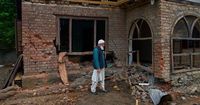In a dramatic escalation of military tensions, India and Pakistan are engaged in their most extensive conflict in decades, with reports of attacks and counterattacks across their shared border. The situation intensified following airstrikes by India on May 7, 2025, which targeted sites in Pakistan and the Pakistan-administered side of Kashmir. This military action came in response to a terrorist attack that had killed 26 civilians in Indian-controlled Kashmir just weeks earlier.
As of May 9, 2025, the conflict shows no signs of abating. Reports indicate that fighting has spread beyond the contested Kashmir region, with accounts of drone strikes and artillery fire reported in various cities, including Jammu and Pathankot in India and areas within Pakistan-administered Kashmir. The Indian Army stated that Pakistani forces had launched drone attacks along its western border, including cities such as Jaisalmer and Amritsar. However, these claims have been firmly rejected by Pakistan, which insists that it has not initiated any attacks against India.
A senior Pakistani government source, speaking to CNN, emphasized that Pakistan is currently prioritizing diplomatic efforts and is not inclined to retaliate militarily until its allies, including the United States and Saudi Arabia, have attempted to mediate the situation. The source stated, “Pakistan is giving space for diplomacy,” denying any allegations that Pakistan had fired missiles or deployed drones against India.
The Pakistani military has accused India of exaggerating the situation, calling it a “fantastic and cooked-up story.” Spokesperson Ahmed Sharif Chaudhry remarked, “It’s such a fantastic and cooked-up story. You can just laugh about it.” On the ground, explosions were reported in Jammu, and police in Pathankot confirmed similar incidents, leading to heightened military readiness in both nations.
World leaders have been urging restraint as the conflict escalates, with U.S. Secretary of State Marco Rubio engaging in discussions with both the Indian external affairs minister and the Pakistani Prime Minister. Rubio expressed support for direct dialogue between the two nations and encouraged ongoing communication efforts. However, direct contact between India and Pakistan remains absent, with only “circuitous channels” being utilized for information exchange.
The recent military confrontations mark a significant shift in the nature of warfare between India and Pakistan, with drones being employed as central weapons in this conflict. This is a notable development, as previous clashes did not see such extensive use of drone technology. The ongoing fighting has led to civilian casualties and widespread fear among residents, particularly in border areas.
In addition to the military actions, the conflict has also affected civilian life significantly. Schools in both Pakistan’s Punjab province and India’s Punjab state have been ordered to close due to safety concerns, with millions of children staying home. Reports indicate that at least 24 airports across northern India have ceased civilian flights, causing significant disruptions in air travel.
The economic impact of the conflict is also being felt, with stock markets in both countries responding negatively to the escalation. India’s main indexes experienced a drop of about 1 percent, while Pakistan’s benchmark index has plummeted by 12 percent since the terrorist attack on April 22. The Pakistan Cricket Board announced that it would relocate the remaining matches of the Pakistan Super League to the United Arab Emirates due to safety concerns.
As the situation unfolds, military analysts are drawing parallels to the last major war between the two nations in 1971. The current conflict has seen both sides engaging in heavy artillery exchanges and airstrikes, with reports of civilian deaths and injuries mounting. The Indian military has claimed that it has successfully thwarted several drone attacks launched by Pakistan, while Pakistani officials assert that they have downed multiple Indian drones.
The roots of the Kashmir conflict date back to the 1947 partition of British India, which created India and Pakistan as separate nations. The two countries have fought three wars since then, with Kashmir being a central issue in each conflict. The recent flare-up began after the April 22 terrorist attack, which India has attributed to Pakistan, leading to heightened military action and accusations from both sides.
In light of the ongoing tensions, Pakistan’s defense minister stated that the government is maintaining daily communication with regional allies, including Saudi Arabia, the United Arab Emirates, and China, to seek a resolution. Meanwhile, the Indian government has suspended participation in a crucial water-sharing agreement with Pakistan, which could have severe repercussions for agriculture and water access in the region.
The Indus Waters Treaty, signed in 1960, has been a contentious point in India-Pakistan relations, and India’s recent threats to withdraw from the agreement have raised alarms in Pakistan. Islamabad has warned that any blockage of water would be considered an “act of war,” intensifying the stakes in this already volatile situation.
The international community is closely monitoring the developments, with diplomatic efforts underway to de-escalate the conflict. However, as both sides continue to exchange fire and accusations, the risk of a broader military confrontation remains a pressing concern.
As the days unfold, the potential for further escalation looms large, with civilians caught in the crossfire and the specter of war hanging over the region once more. The world watches as India and Pakistan grapple with their long-standing grievances and the dire consequences of their military actions.




